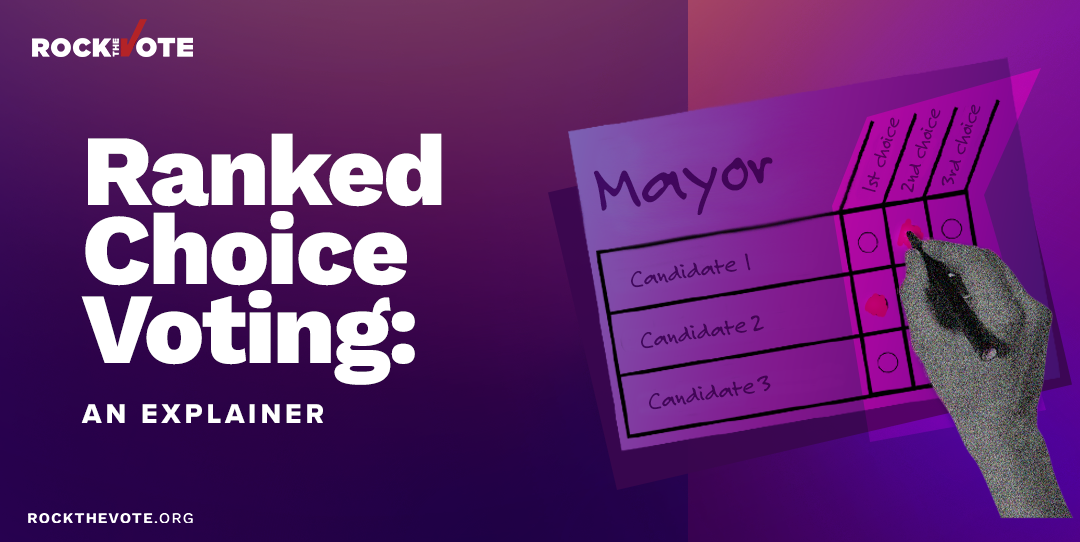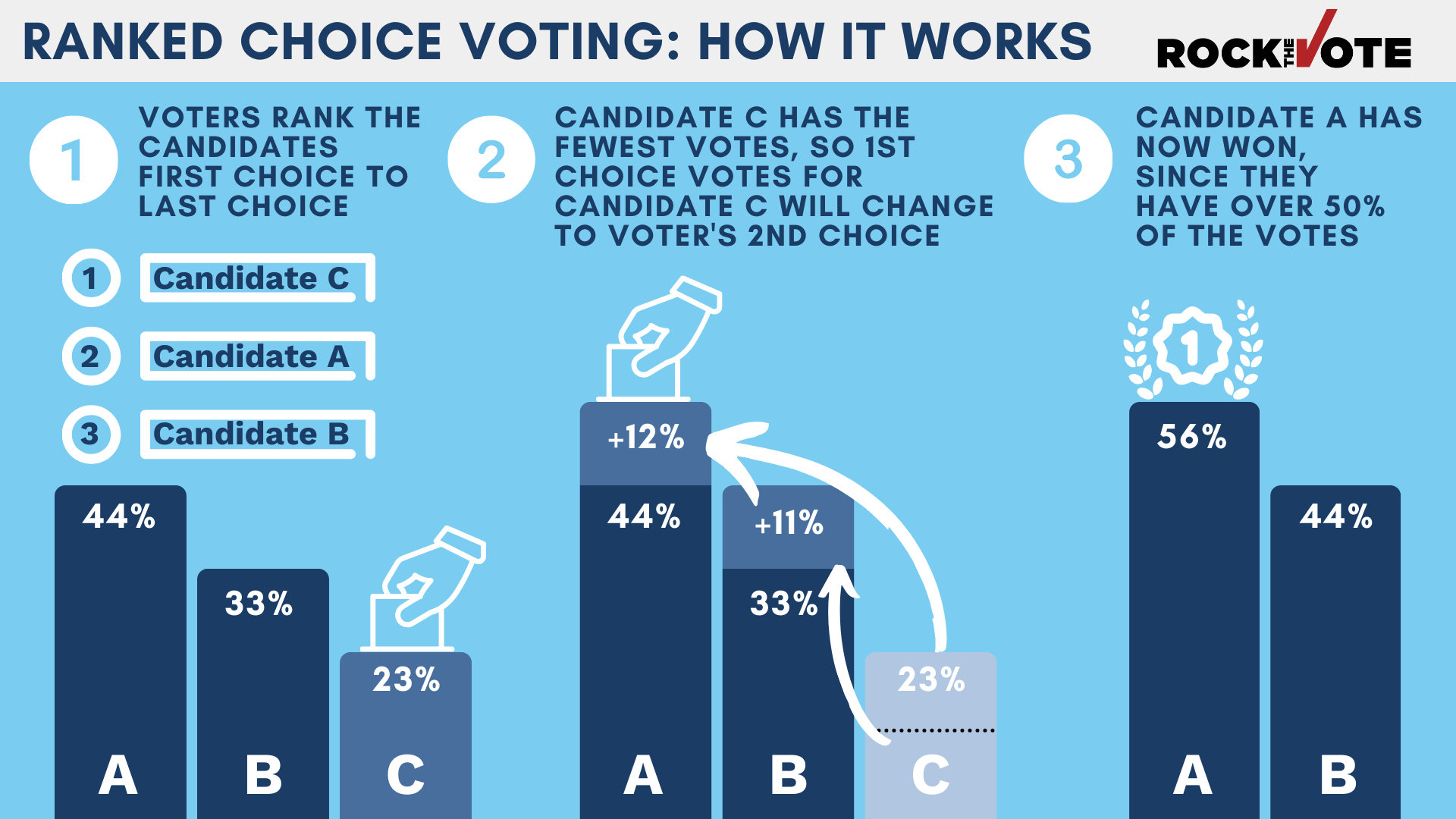
What is Ranked Choice Voting?
Ranked Choice Voting (RCV) is a system of voting in which voters rank candidates on their ballot in order of preference. It may also be referred to as Alternative Vote or Instant Runoff Voting.
Generally speaking, in Ranked Choice Voting, a candidate who earns more than 50% of the vote wins. If no candidate has won more than 50% after every voter’s first choice vote is counted, the candidate with the fewest votes is eliminated. The ballots with the now-eliminated candidate ranked as first are then redistributed to their respective second-choice candidates, and votes are recounted. This process repeats until a candidate has a majority of support from the constituency.
RCV is a form of voting that more accurately represents the full spectrum of voter’s preferences and helps elect a candidate that better reflects the majority of voters.

Don’t We Already Have Majority Representation?
The short answer to this question is… sort of. The majority of elections throughout the U.S. currently use a system known as plurality voting or first-past-the-post (FPTP). To win within this system, a candidate just needs to obtain more votes than any other candidate – a plurality of votes, rather than a majority of voters (over 50%). In other words, a candidate who receives 20 percent of the votes would win in a winner-take-all system, so long as all other candidates received less than 20 percent. In this example, 80 percent of voters voted against the winning candidate.
In winner-take-all, the fewer the number of candidates the larger the plurality of the votes the winner will receive. The greater the number of candidates, the more likely the votes will be split into smaller percentages. This is even more true if candidates share aspects of platform or appeal. To consolidate votes to ensure a winning candidate, parties consolidate candidates and their platforms thereby reinforcing the two-party system.
A two-party system encourages people to vote for the “lesser of two evils” rather than voting for candidates that more accurately represent their values. Some voters even cast their ballot simply in opposition to a candidate rather than for a candidate who aligns with their personal beliefs.
What are the Advantages of Ranked Choice Voting?
RCV Saves Money and Increases Turnout
Currently, primaries, runoffs, and other elections that do not take place on general election days suffer from low and unrepresentative turnout and cost more money. With RCV, voters enjoy the benefits of two or more rounds of voting in a single, more representative, higher-turnout election. This is why single-winner RCV is also known as “instant runoff voting.”
Notably, RCV promotes increased participation from military and overseas voters. Federal law requires states to provide military and overseas voters with ballots at least 45 days before any federal election, but runoff elections require a new set of ballots. Sending a second set of ballots requires an enormous delay, driving down turnout in the runoff election. With RCV, there is no need for runoffs, which means military and overseas votes would be cast and counted meaningfully without need for a second ballot.
RCV Promotes Participation Offering Voters More Choice
It can be disheartening for voters to feel like they can only vote for the lesser of two evils or what they don’t want instead of what they do. This dilemma can make it difficult to remain civically engaged. Ranked Choice Voting can help resolve this dilemma.
Under RCV, voters are able to rank candidates according to their support preference. Voters know that if their first choice doesn’t win, their vote automatically counts for their next choice instead; this way, there is less pressure on the voter to compromise on their beliefs or feel like they are “throwing away” their vote by supporting a less popular candidate. RCV eliminates the pressure many voters feel in voting for the “lesser of two evils” and provides opportunities for independent voters to have a wider range of choices.
RCV Promotes Majority Support
In elections in the United States where more than two candidates compete, candidates often win with less than 50% of the vote. When this happens, it means that over 50% of voters voted against the winning candidate.
Under RCV, if no candidate wins a majority of voters’ first-choices votes, the candidates in last place will be eliminated one by one and their votes will be redistributed. If a voter’s first choice is eliminated, their vote instantly goes to their second choice. That way, only a candidate with a majority of voters’ support wins.
RCV May Lessen Negative Campaigning and Polarization
In winner-take-all elections, candidates often attack their opponent(s) in an attempt to highlight their differences, which can lead to toxic campaigns and polarized politics. With RCV, candidates compete for second-choice votes from their opponents’ supporters, which disincentivizes candidates from running negative campaigns. In RCV contests, candidates do best when they reach out positively to as many voters as possible, including those supporting their opponents in hopes of earning a second or third spot on a voter’s ballot.
RCV Promotes More Diversity Among Candidates and Independent Candidates
To avoid “vote splitting,” parties and campaigns often attempt to limit the number of candidates that enter an election. While smaller political parties exist in the United States, they rarely gain a significant portion of votes to win. As a result, our current winner-take-all system often treats third party candidates, and even less popular candidates from one of the two major parties, as “spoilers” that take votes away from the leading candidates.
Candidates from historically underrepresented communities – women, people with disabilities, members of the LGBTQ+ community, Black, Indigenous, People of Color – are sometimes pressured to stay out of the race for fear of splitting the vote with another candidate who may attract similar voters. This leads to less diverse candidates and elected officials. Under RCV, candidates are less likely to be pushed out of the race because of their similar platform resulting in more diverse candidates and independents on the ballot – and in office.
RCV Promotes Reflective Representation
A 2018 study of four cities with RCV elections found that more candidates of color were elected to office under RCV than the cities’ former election systems. According to the report, possible explanations for how RCV contributes to increased representation of people of color include:
- RCV features a single, general election – which is regularly an election with higher turnout from a more diverse population.
- In districts where white voters make up the plurality but several ethnic groups collectively make up the majority, candidates of color have a greater chance of being elected through coalition-building campaigns.
- Campaigns are less costly to run since they are shorter, which means money, which is often an inhibiting factor for candidates that are not a part of the largely-white establishment, has less influence.
These factors combined promote diversity of political viewpoint as well as diversity of candidate background and demographics.
Does Ranked Choice Voting Already Exist Anywhere?
Popular in many countries around the world, RCV is used for national elections in Australia, New Zealand, Fiji, Malta, Northern Ireland, Papua New Guinea, and Ireland.
In the United States, RCV has been implemented in some form in half of the 50 states. Maine and Alaska use RCV for all elections. In addition, several other jurisdictions, including New York City and San Francisco, have implemented RCV for certain elections.
What Does the Future of Ranked Choice Voting Look Like?
Ranked Choice Voting is becoming increasingly popular across the United States, especially as the American people look for ways to improve the health of our democracy and address the intense polarization that is plaguing the country.
Support Ranked Choice Voting
An electoral system that encourages diversity of thought and fairer representation is a better, more democratic system. Such a system can be made possible through the implementation of Ranked Choice Voting in the United States. Here are a few ways you can learn more and support RCV:
- Contact your local, state, and federal elected officials to let them know you would like to see RCV elections implemented in your community. You can find out who represents you at the state and federal levels and how to contact these officials here.
- Talk to your friends and family about RCV so that it can be more widely understood, supported and implemented.
- Lobby your school to use RCV in its student council elections or where other voting opportunities exist, such as Homecoming or Prom Court. It’s a great way to introduce how RCV works and its benefits to a large audience who then can help you advocate for it in your local elections.
Published February 7, 2023. Updated February 19, 2025.
